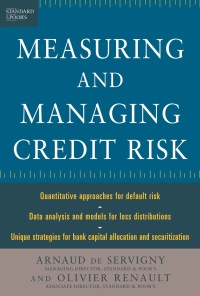Question
Project S has a cost of $10,000 and is expected to produce benefits (cash flows) of $3,500 per year for 5 years. Project L costs
Project S has a cost of $10,000 and is expected to produce benefits (cash flows) of $3,500 per year for 5 years. Project L costs $25,000 and is expected to produce cash flows of $8,000 per year for 5 years.
-
Calculate the two projects' NPVs, assuming a cost of capital of 14%. Round your answers to the nearest cent.
Project S $ Project L $ Which project would be selected, assuming they are mutually exclusive?
- Calculate the two projects' IRRs. Round your answers to two decimal places.
Project S % Project L % Which project would be selected, assuming they are mutually exclusive?
-
Calculate the two projects' MIRRs, assuming a cost of capital of 14%. Round your answers to two decimal places.
Project S % Project L % Which project would be selected, assuming they are mutually exclusive?
- Calculate the two projects' PIs, assuming a cost of capital of 14%. Round your answers to two decimal places.
Project S Project L Which project would be selected, assuming they are mutually exclusive?
Which project should actually be selected?
The Campbell Company is considering adding a robotic paint sprayer to its production line. The sprayer's base price is $1,140,000, and it would cost another $23,500 to install it. The machine falls into the MACRS 3-year class (the applicable MACRS depreciation rates are 33.33%, 44.45%, 14.81%, and 7.41%), and it would be sold after 3 years for $506,000. The machine would require an increase in net working capital (inventory) of $8,000. The sprayer would not change revenues, but it is expected to save the firm $403,000 per year in before-tax operating costs, mainly labor. Campbell's marginal tax rate is 35%.
- What is the Year 0 net cash flow? $
- What are the net operating cash flows in Years 1, 2, and 3? Do not round intermediate calculations. Round your answers to the nearest dollar.
Year 1 $ Year 2 $ Year 3 $ - What is the additional Year 3 cash flow (i.e, the after-tax salvage and the return of working capital)? Do not round intermediate calculations. Round your answer to the nearest dollar. $
- If the project's cost of capital is 13 %, what is the NPV of the project? Do not round intermediate calculations. Round your answer to the nearest dollar. $ Should the machine be purchased? -Select-YesNo
Step by Step Solution
There are 3 Steps involved in it
Step: 1

Get Instant Access to Expert-Tailored Solutions
See step-by-step solutions with expert insights and AI powered tools for academic success
Step: 2

Step: 3

Ace Your Homework with AI
Get the answers you need in no time with our AI-driven, step-by-step assistance
Get Started


